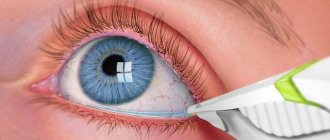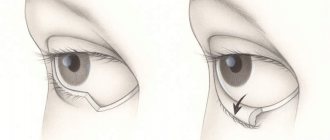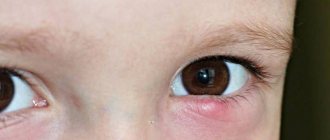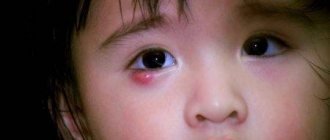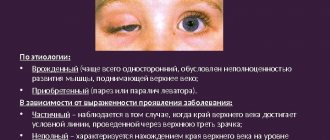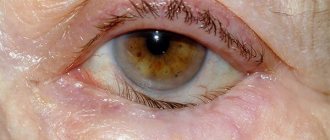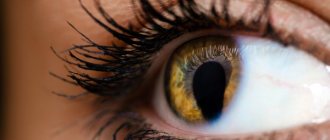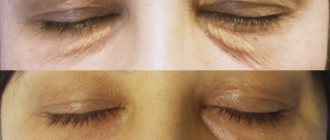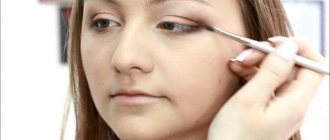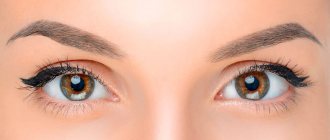Symptoms
You should not ignore stye on the eye, since the process of development of acute inflammation of the hair follicle of the eyelash (or the Zeiss sebaceous gland) is considered a disease and requires certain treatment. You can recognize it by the following signs.
- Redness of the Lower Eyelid, accompanied by painful sensations and increasing swelling.
- Itching along the eyelash line.
- Formation of a rounded head in the area of increasing swelling. Pus begins to accumulate in the center of the red dot for 2-3 days. Sometimes several heads appear. In the case of internal styes, the abscess is not visible.
- The process of growth of purulent formation is accompanied by discomfort and pain, which intensifies every day. The itching also intensifies.
- As swelling increases, there is often difficulty opening the eyes, which causes loss of visual acuity and a blurry picture.
- Unpleasant sensations are complemented by the feeling of a foreign particle in the eye or sand.
- The secretion of tears increases.
In addition to these symptoms, the patient may experience a headache. An increase in body temperature to 37.8° is often observed. When palpating the lymph nodes (in the neck), their enlargement is noted.
Treatment with folk remedies
Barley is not the most serious disease, but it is unpleasant, so since ancient times people have been looking for ways to quickly and effectively cure it. Through trial and error, techniques were found that allowed the abscess to go away in a couple of days without reappearing for a long time. Before using any of the methods outlined below, you need to make sure that you have no contraindications to the drug you are going to try. It is best to consult a doctor who, based on the individual characteristics of the body, will determine a list of possible methods.
- In the first hours of the manifestation of alarming symptoms, it is important to stop the inflammatory process and destroy harmful bacteria. An alcohol compress can help with this. Pure alcohol can leave burns on the sensitive skin of the eyelids, so it is better to use vodka, in which you should dip a cotton pad and apply it to the stye. It is important to wring out the cotton pad completely so that the vodka does not get into your eye. You need to keep the compress for at least 10 minutes, avoiding any unpleasant sensations; if a burning sensation occurs, you should immediately interrupt the procedure.
- Plantain, known for its healing properties, can help treat stye. To do this, you need to take 3 tablespoons of clean, washed plantain leaves and brew them in 200 ml of boiling water. Keep warm, wrapped in a towel, for about an hour. Then you need to strain the infusion and make compresses.
- A homemade aloe plant can help out if an abscess appears on the eye. One medium-sized leaf should be washed and the juice squeezed out of it. Dilute the resulting amount with clean water in a ratio of 1 to 10. Moisten a cotton pad with the resulting solution and press it to the sore eye three times a day.
- Calendula flowers are a popular folk remedy against styes; they are sold in any pharmacy and are quite inexpensive. A tablespoon of herb should be brewed in 200 ml of boiling water and left for half an hour. This infusion is also used to make lotions on the sore eye.
- Garlic is an effective remedy in the treatment of barley due to its bactericidal properties. You need to extract the juice from one clove of garlic by crushing it on a saucer with a knife blade. The released juice should be lubricated with the barley using a clean cotton swab, or your hands should be washed thoroughly before the procedure.
- Another option for using garlic is to apply a fresh cut clove to barley. You can also boil the clove and mash it until it becomes mushy. Wrap the resulting pulp in a piece of gauze and apply to the affected area.
- At the first signs of barley, baking soda will help interrupt the inflammatory process. One tablespoon of baking soda should be diluted in a glass of warm water, and compresses should be made from this solution every time tingling or redness begins.
- Propolis tincture is a remedy that should be in every home in case of barley. In the first hours of the development of inflammation, you need to moisten a cotton swab with propolis tincture and lubricate the area where the discomfort appeared.
- Castor oil will help get rid of an abscess quickly. However, the method of using it is not as simple as previous recipes. Gauze, folded in several layers, should be moistened with castor oil and secured with a bandage on the sore eye. This compress should be kept for several hours, ideally all night, repeated 2-3 times.
Kinds
Considering the location and the number of inflamed points, barley is divided into two types.
External - located along the edge of the eyelid, clearly visible. This type is the most common. Characterized by rapid spreading to adjacent tissues. The danger of external styes lies in the increased risk of the formation of a wound or purulent abscess in the affected area of the eyelid.
Internal - the source of inflammation is localized in the cartilage of the eyelid plates. The main reason is suppuration of the meibomian glands. The abscess is not visible from the outside of the eyelid; only swelling and redness are noticeable. The danger of this type is the development of chalazion.
The external appearance of a purulent formation on the eye is considered more dangerous than the internal one. This is explained by the danger of infection of the eye if pus is opened and gets into the mucous membrane.
In medicine, barley is also classified by the number of pustules in the area of damage to the tissue of the eyelid. If 2 or more white heads are formed at the same time, then the impact of both one and two inflammations is possible. In this case, the upper and lower eyelids may be affected simultaneously in the affected eye. This etiology of the disease often indicates a weakened immune system.
Important! Barley cannot be left without treatment due to the high risk of complications and vision problems.
Reasons for appearance
An abscess appears due to blockage of the lacrimal gland or hair follicle by some microparticle or bacteria. Staphylococci and streptococci are the most common causes of the disease. The staphylococcus bacterium is harmless in normal environments and is often found on the skin of the hands and nasal mucosa. As soon as the bacterium enters a favorable environment, the inflammatory process begins - redness, pain, itching, suppuration. Other microparticles - smoke, dust, cosmetics - can also penetrate the pores. By themselves, these substances cannot cause inflammation; it begins, as a rule, due to a general weakening of the body.
Reasons that can cause an abscess on the eye:
- decreased immunity, due to which the body is unable to resist infection; occurs, as a rule, after infectious diseases;
- a lack of vitamins and minerals can also weaken the body’s protective functions and contribute to the development of inflammation;
- hypothermia in itself is not a direct cause, but against its background a sharp decrease in immunity may occur;
- disruptions to the digestive tract can impair the absorption of beneficial microelements and also reduce immunity;
- the presence of other diseases of the mucous membrane of the eyes - blepharitis, demodicosis.
It is also believed that an increased risk of illness accompanies diseases such as diabetes mellitus and other endocrine system disorders.
Causes of stye on the lower eyelid
Several factors can provoke purulent formation in the lower eyelid.
- Reduced immunity, which often weakens after suffering from colds, surgery or serious injuries.
- Infections. Among the common infectious diseases is Staphylococcus aureus.
- Seasonal hypovitaminosis resulting from unbalanced nutrition and anemia.
- Pathological processes occurring in the endocrine system.
- Ignoring personal hygiene rules (using personal hygiene items in public places, rubbing eyes with unwashed hands, etc.).
- Ophthalmological diseases (conjunctivitis, blepharitis, which occurs in a chronic form).
Reference! Even low-quality cosmetics can provoke the formation of an abscess on the eyelid. When choosing care products, you need to pay attention to the components of the composition and expiration date. After expiration of the shelf life, a high-quality product becomes poison for the human body.
Classification and symptoms, photos
Inflammation of the eyelid, photo 1
The classification of eye diseases is very extensive. Most of them have similar symptoms and development mechanisms. The causative agents are usually bacteria - cocci. Such microorganisms are transmitted by contact, i.e. Even rubbing your eyes with dirty fingers will be dangerous. Often the pathological process becomes complicated in the absence of treatment.
For example, at first a person experienced a simple inflammation of the eyelid - stye, but this event was not given any significance, which led to a worsening of the situation in the form of the formation of phlegmon or an abscess.
But not only bacteria provoke eye diseases. Sometimes viruses also become pathogens. This affects the nature of the disease, because the life processes of these microorganisms are different. If a patient has been diagnosed with “inflammation of the upper eyelid,” signs may also appear on the lower eyelid: germs are easily spread by the person himself due to careless rubbing with his fingers.
So, the classification of eyelid inflammation and characteristic symptoms:
1. Barley:
- inflammation of the edge of the eyelid;
- redness of the surrounding skin and conjunctiva;
- purulent abscess.
2. Meibomeitis:
- inflammation of the meibomian glands;
- the process is localized in the depths of the eyelids;
- purulent abscess;
- redness of the conjunctiva;
- Yellow or gray crusts collect in the corners of the eyes.
3. Impetigo:
- small pustules;
- spread from the skin of the face to the eyelids;
- It occurs more often in children than in adults.
4. Furuncle:
- dense formation with pus inside;
- severe swelling of the eyelid.
5. Blepharitis:
- inflammation of the edge of the eyelid;
- eye fatigue;
- heaviness of the century;
- increased sensitivity to light;
- redness and thickening of the eyelid;
- eyelash loss;
- itching and burning.
6. Molluscum contagiosum:
- causative agent - poxvirus;
- small skin thickening;
- no pain.
7. Abscess and phlegmon:
- exacerbation of inflammation;
- the formation of a large amount of pus;
- strong pain.
Among the types of inflammation of the eyelids, blepharitis has the largest number of manifestations. The disease develops as a result of a bacterial infection, but the routes of penetration of microorganisms are very diverse. This could be a complication of dermatitis or stye, the spread of acne to the skin of the eyelids, or a common allergic reaction. In addition, the disease occurs due to the fault of lice, which carry microbes.
Doctors distinguish the main types of blepharitis:
- scaly (a simple form characterized by gray scales);
- tick-borne (transmitted by a tick bite, the eyelid swells and itches);
- allergic (reaction to medications, food or seasonal pollen);
- Rosacea (pink nodules with pus on the eyelid);
- ulcerative (the most painful form, in which pustules form along the eyelash line).
Diagnostics
The signs of barley are so specific that they are familiar to almost every person. However, you should not rely on your own opinion when diagnosing a problem; symptoms may indicate other, more serious pathologies.
For example, cystic and tumor formations. A qualified doctor will be able to accurately determine the diagnosis after examining the affected area of the eyelid.
In addition to visual signs, the ophthalmologist studies symptoms. If there are any controversial issues or doubts, the following studies are carried out.
- Blood test for sugar levels.
- Microscopy of eyelashes for the presence of mites.
- Biological seeding.
- A smear from the conjunctiva to identify the causative agent of barley.
- Analysis of stool for parasite eggs.
Differential diagnostics are also carried out:
- chalazion;
- cystic formations and oncology of eyelid tissues;
- dacryoadenitis.
Development of eye disease
A disease associated with an inflammatory process in tissues develops quickly. In a short time, one symptomatology is complemented by other characteristic signs. At the initial stage, the edge of the eyelid is very itchy, after which redness and swelling appear.
On the second day, local swelling is clearly visible, which constantly hurts. The second and third days of development of the inflammatory process are accompanied by an increase in swelling and the formation of a red ball along the edge of the eyelid, where pus collects. The swelling can grow so intensely that sometimes the eye opens with great difficulty.
After 3 days, the purulent head becomes pronounced, and the pain is muffled. After opening the abscess, a white, yellowish substance is released from the sac. At the final stage, regression of all symptoms is noted. The total duration of the purulent-inflammatory process is 5-7 days.
Origin and symptoms of ulcers on the eyelid
Purulent formations can provoke the following diseases and conditions:
- An abscess is an acute inflammatory process in which an abscess with purulent contents forms on the mucous membrane of the eyelid. This process is a complication that provokes other eye diseases (hordeolum, blepharitis, meibomitis and others). The abscess has a yellowish, sometimes gray color, and it is very painful to touch. After the wound bursts, purulent fluid flows out of it, the pain immediately disappears. An abscess has the same symptoms as cellulitis.
- Molluscum contagiosum is a viral disease caused by poxvirus (smallpox virus). Previously, doctors associated the occurrence of pathology with the vital activity of the mollusk. You can become infected with the virus through contact with a carrier, using someone else's towel or other personal items. A feature of this infection is the formation of dense formations on the mucous membrane of the lower eyelid, which are painless when touched. The disease can lead to chronic keratitis, conjunctivitis, and blepharitis.
- Stye is an abscess on the edge of the lower eyelid. This disease is caused by staphylococcus of the sebaceous gland. The main sign of the disease is the appearance of a bulge on the mucous membrane of the eyelid, which causes pain. There is redness of the skin around the seal, and the conjunctiva also becomes inflamed. Usually the abscess breaks out in 2-4 days. Sometimes several seals form on the eyelid at once.
- Blepharitis is an inflammatory process in the area of the ciliary end of the lower eyelid. This disease is mainly chronic.
Types of blepharitis:
- angular;
- ulcerative;
- scaly;
- meibomian.
Symptoms common to all types of blepharitis are a feeling of eye fatigue, heaviness of the eyelids, and sensitivity to bright light. The eyelids become slightly swollen, dense, and reddened. The patient feels itching and burning in the eye. In some cases, eyelashes begin to fall out. Blepharitis is a complication of certain skin diseases, such as seborrheic or simple contact dermatitis, allergies, acne, lice.
- A furuncle or boil is a bulge in the eyelid area that has purulent contents and is accompanied by swelling. A black dot forms inside the boil, which is called a necrotic center. After the boil breaks out, the pus comes out along with the necrotic core. Almost always, after the wound heals, a scar remains on the affected area.
- Impetigo is a skin disease that spreads to the eyelid from other parts of the body. It is transmitted through contact and household contact. The abscesses are small in size and heal on their own within 2 weeks. This disease does not cause any complications. Its causative agents are streptococci and staphylococci. Children most often suffer from impetigo.
- Meibomitis is an inflammatory process in the meibomian glands (glands of the cartilage of the eyelid). This disease is caused by coccal forms of bacteria. The symptoms of meibomitis are similar to those of stye. They differ in that with barley, the abscess forms on the edge of the eyelid, and with meibomitis - in its depths. Sometimes the abscess needs to be opened surgically. Yellow or gray crusts form in the corners of the eyes. Discharges constantly come out of the glands, which can provoke the development of chronic conjunctivitis.
Features of treatment in adults/children
The immune system of an adult is fully formed, so inflammation and its consequences are eliminated faster than in small patients. For the same reason, the percentage of diseases in children is higher. A child’s body can give an adequate response to pathological processes only after reaching the age of seven.
In addition to the listed reasons for the occurrence of barley, the children's list is replenished with the following provoking factors.
- Transitional age when hormonal imbalance is noted.
- Wearing lenses. The risk of infection lies in non-compliance with hygiene rules when putting on optics.
- Heredity. Predisposition to the disease is programmed into DNA.
- Infection of the entire family or its individual members with Staphylococcus aureus.
To treat purulent inflammation of the eyelid in adult patients, both traditional methods and special pharmacological agents are used. In severe cases, complex therapy with antibiotics is prescribed.
To eliminate the signs of barley in children, only safe and proven means are used. In case of frequent cases of pustules appearing on the eyelid of a small patient, additional studies are recommended to exclude suspicions of other diseases with similar symptoms.
Reference! An ophthalmologist treats stye.
How to treat eye stye: various techniques
To eliminate the problem associated with the formation of an abscess in the lower eyelid, methods of traditional and traditional medicine are used.
Medication
Placing ointment behind the eyelid
If procedures using herbal remedies are unsuccessful, it is recommended to consult an ophthalmologist to select a medication. Medical care is especially important if there are signs of complications. The disease is treated with special ointments, drops and other forms of medication.
- Eye ointments are selected with a composition that is intended to treat inflammation and infectious diseases. This group includes the following products: Tetracycline ointment, Hydrocortisone ointment, Yellow mercury, Floxal ointment.
- Eye drops are also selected with antibacterial and anti-inflammatory effects. Among the popular and effective solutions: Hydrocortisone, Prednisolone, Levomycetin, Albucid.
- Vitamin therapy will help strengthen the body’s protective function and replenish the deficiency of useful microelements.
Reference! Sometimes the patient is prescribed surgery to remove pus from the sac. This approach is used in cases where drug treatment has not brought the desired effect.
Folk
In folk medicine, there are many recipes for barley, some of which are no less effective than pharmacological drugs. In some cases, it is enough to rinse the sore eye with tea leaves several times a day. If this option does not help, you can use more effective methods.
- Applying washed plantain leaves overnight. The plant is fixed with a loose bandage.
- Lotions made from brewed calendula inflorescences. Dry or fresh flowers should be poured with a glass of boiling water and left in a closed thermos to infuse (about 30 minutes). Make compresses 4-6 times a day, holding a moistened cotton pad on the abscess for 5-7 minutes.
- Compresses made from crushed aloe pulp. Prepared from freshly cut leaves. Place the resulting mass on a bandage and apply it to the barley. Hold for 7 minutes. The number of repetitions of procedures is 3-4 times a day.
- Treatment of an abscess with propolis tincture. You can buy it at the pharmacy or prepare it yourself. The procedure should be carried out using a cotton swab 3-5 times a day.
- Lotions made from a decoction of a mixture of bactericidal herbs. You can use any mixture, for example, chamomile + calendula + St. John's wort. The herb is infused with boiling water for 20-30 minutes. Keep a moistened cotton pad on your eye for 5-7 minutes.
Watch a video about traditional methods of treating barley:
Treatment of inflammation of the eyelid
Official medicine can cope with inflammation of the lower or upper eyelid. Traditional healers also offer effective recipes. If you approach treatment comprehensively, the disease will recede quickly enough. Doctors pay attention to general principles that must be followed when choosing how to treat inflammation of the eyelid:
- Do not rub your eyes with your fingers.
- Limit visual stress (no TV or computer monitor).
- Strengthen your immune system with vitamins and a balanced diet.
Medicines
How to treat inflammation of the eyelid? First of all, the therapeutic course depends on the cause of the disease. In case of allergies, antihistamines and elimination of the source of irritation will be required, and in case of injury, you need to focus on eliminating the damage. If another disease provokes inflammation of the eyelid, treatment should be directed to the primary pathology.
If the disease is infectious, antibiotics are used locally and internally. In general, the list of effective drugs is as follows:
1. Inside:
- Ampiox;
- Oxacillin;
- Biseptol.
2. Eye drops:
- penicillin;
- sodium sulfacyl;
- prednisolone;
- hydrocortisone.
3. Eye ointments:
- tetracycline;
- yellow mercury;
- furacilin;
- gentamicin.
Boils and pustules are sometimes opened with a surgical instrument, cleaned and disinfected with iodine or brilliant green. The patient usually experiences relief immediately after the intervention. If the disease is not accompanied by pronounced formation of pus, then doctors do not prescribe oral medications (for example, with scaly blepharitis or impetigo). But local antibiotics are used in any case.
Folk remedies
Folk remedies for the treatment of inflammation of the eyelids, photo 3
For inflammation of the eyelid, treatment with folk remedies is recommended in the absence of purulent formations. Doctors emphasize that bacterial infections should only be fought with antibiotics.
However, inflammation can also occur due to prolonged visual stress. This type of disorder especially often affects children and adolescents who spend a lot of time in front of monitor screens. What does traditional medicine advise?
1. Kalanchoe or aloe:
- squeeze the juice from a leaf of the plant;
- drip 1-2 drops three times a day.
2. Calendula or chamomile:
- 2 tsp dried and chopped herbs pour 1 tbsp. boiling water;
- leave for 40 minutes;
- filter thoroughly;
- using a pipette, instill 1-2 drops into the eyes;
- repeat 3 times a day.
3. Propolis (effective for blepharitis):
- grind 5 g of propolis;
- mixed with 100 g of Vaseline;
- placed in a dark bottle;
- apply a thin layer of ointment to the inflamed eyelids;
- after 6 hours, repeat the procedure;
- take a break for 10 hours and apply the ointment again.
4. Clover (cornflower and parsley are prepared in the same way):
- 1 tbsp. dried and chopped herbs pour 1 tbsp. boiling water;
- leave for 20 minutes and filter (cornflower and parsley leave for 40 minutes);
- moisten the gauze and apply it to the eyelids for 10 minutes;
- repeat three times a day.
What not to do with barley
Barley ripens within 5-7 days. During this period, some restrictions must be followed.
- During the treatment of inflammation, you should stop using cosmetics (even good quality).
- Wearing lenses increases pain, so it is worth switching to wearing glasses for a while.
- You cannot squeeze out the purulent head before its maturity.
- Do not apply a hot compress to the site of the outbreak.
- You should not wipe barley with alcohol, iodine, or brilliant green.
If the recommendations are not followed, the risk of re-infection and the development of complications increases.
Possible complications
Orbital phlegmon is one of the possible complications.
Inflammation in the area of vision should not be taken lightly; the consequences of lack of treatment can be serious. It is undesirable to self-medicate, because under the signs of ordinary barley a dangerous disease may be hidden.
If medical care is provided incorrectly or there is no treatment at all, the risk of complications increases, the cause of which lies in the spread of the inflammatory process to neighboring tissues and cells. Among the dangerous consequences:
- meningitis;
- phlegmon of the orbit, in which the mobility of the eyelids is limited;
- sepsis;
- purulent conjunctivitis;
- thrombosis of the cavernous sinus of the brain (can be fatal).
Preventive measures
If you follow all the doctor’s instructions, you can cure stye quickly, and most importantly, without consequences. To prevent repeated cases of abscess formation in the lower eyelid, it is recommended to follow simple rules:
- touching the eyes is permissible only with clean hands;
- perform proper personal hygiene procedures;
- review your diet, introduce more fresh vegetables and fruits into it;
- in the off-season, use a vitamin complex to replenish the deficiency of vitamins and minerals in the body;
- refusal to use low-quality or expired cosmetics;
- avoiding the use of ice in the eye area during cosmetic procedures.
If barley does appear, opening the abscess before its maturity is prohibited. When removing the substance from the bag, it is worth preventing it from getting on the mucous membrane.
What doctors say about the nature of the appearance and treatment of barley:
Prevention: effective measures
This may sound like a truism, but strengthening the immune system is the most important means of preventing the occurrence of boils on the eye.
You can help activate the body's defenses with a balanced diet, sufficient physical activity, exposure to fresh air, and a reasonable alternation of exercise and rest.
Here are a few more simple but effective rules for preventing boils:
- do not touch your eyes with unwashed hands;
- Keep your hands clean regularly;
- do not allow dust and particles of foreign bodies to get into your eyes;
- use high-quality hypoallergenic cosmetics;
- Do not use other people's cosmetics and towels.
Paying attention to your own health will help prevent many diseases, including the appearance of a boil on the eye.
It is important to notice the symptoms of a developing disease in time and take action - seek qualified medical help.
Timely treatment in most cases guarantees a complete cure without undesirable consequences.
Every person can experience eye diseases. Inflammation of the eyelid can occur either independently or together with another infection. Pain, compaction, and swelling often provoke dysfunction of the organ of vision. To avoid this, it is necessary to identify the causes of the disease and begin treatment.
